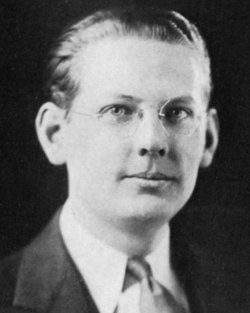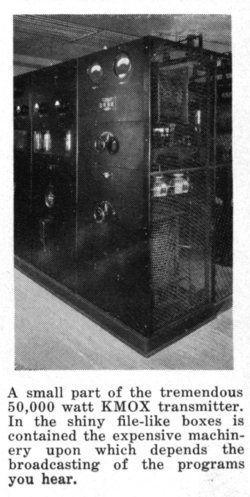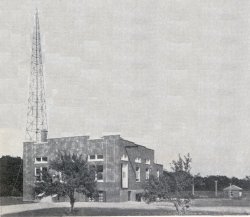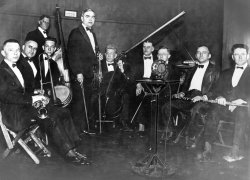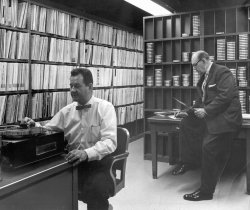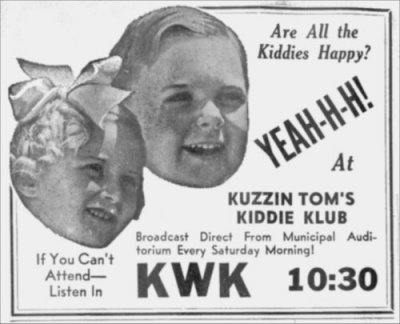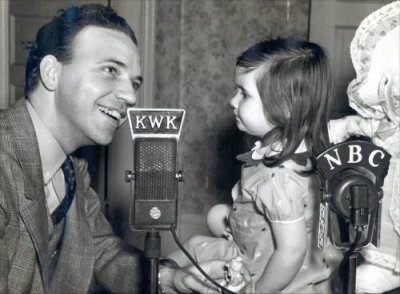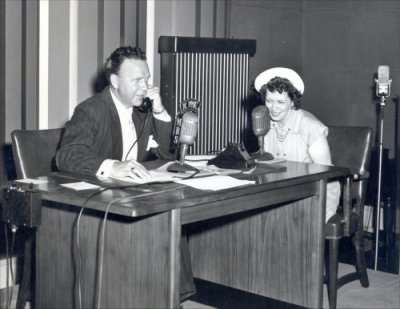Radio Articles
The Top St. Louis Radio Drama
What began on KMOX in 1937 became a bastion of radio drama for 25 years in St. Louis, thanks in part to the work of a twenty-something man named Kensinger Jones.
“The Land We Live In” was a presentation of Union Electric, heard at 5:30 Sunday evenings and performed before a studio audience. Each episode was a recreation of an historic event or series of events from the St. Louis area. Ken Jones was hired by KMOX in 1945, ostensibly as a continuity writer, but as he put it more succinctly, “My real work was to make sure there was never again a shortage of scripts for ‘The Land We Live In’ radio show.” He and his young wife Alice worked in conjunction with director Ted Westcott and music director Seth Greiner (Alice was never on the payroll) to produce 52 half-hour shows a year.
Even though that number was later cut to 39, the schedule was brutal. Jones says he did get some help from free-lance writers from time to time, but he still was expected to be the script editor.
An average week, Jones says, went something like this: “From 1946 on, Alice and I lived in a log house just outside of House Springs. That’s where I wrote the shows. We’d do our research at the Central Library, the Missouri Historical Society, and by visiting individuals related to stories. That would take Saturday through Tuesday or Wednesday.
“I’d write frantically on Wednesday and deliver the script to KMOX at the Mart Building where it had to be duplicated. Copies would go to Ted Westcott for casting, Seth Greiner for music, and to Walter Heren at U.E. for client approval. There would be a quick rewrite and then a full cast and orchestra rehearsal.
“Then the show would be timed and recorded. On Thursday morning the rehearsal record would be played for the agency and the client. Their suggestions were cranked into a final rewrite on Friday or maybe Saturday. On Sunday at 2:45, a rehearsal with rewritten ‘final’ scripts commenced. A timed run through occurred from 4 – 4:30. Ted raised his hand and threw the first cue at 5:30. Usually by that time I was back in House Springs working on the next show.”
His wife Alice adds that he was often researching several shows at the same time, and he was picking up free-lance work on the side and writing other shows for KMOX.
Sponsor Union Electric decided in the late 1940s to move the show from KMOX to KSD, and the writers and producers moved too.
In conversation with Kensinger Jones, it’s obvious he and Alice loved what they were doing. They dug deeply into St. Louis history, and while it would be impossible to recreate historically accurate dialog, all facts represented on the show were correct. Suggestions for show topics would come in from listeners, some of whom had material to help the Joneses in their research.
As Ken Jones says, in radio, sound effects, words and music, along with the listeners’ willing imagination, can create anything you want, from a skirmish to a full scale battle. “The theater of the mind is surely the best auditorium ever provided for a writer’s work.”
The scope of their accomplishment is even more admirable when one realizes that this was done before computers, before word processors, before the Internet. The late Bea Adams, who worked at UE’s ad agency, Gardner, wrote of this process in her book Let’s Not Mince any Bones, “In an office only big enough for a small desk, typewriter, chair and raft of reference books, Kensinger Jones wrote “’The Land We Live In.’ He wrote it, lived it, researched it, personally watched over it and shaped it into one of the finest radio shows ever to come out of St. Louis.”
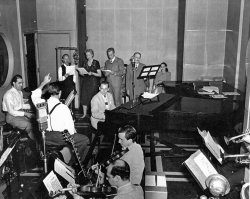
An October 1975 St. Louisan magazine article penned by Nancy Leutwiler told of our town’s local actors who made a good living as regulars on “The Land We Live In.” Hiring was usually done through the St. Louis Players’ Guild, depending on the number of characters needed for the week’s production.
If only a few were needed, they came from the on-air staff of the individual radio stations. Conditions for the actors could be as stressful as they were for the writers. ”
The first run-through came Thursday afternoon when parts were assigned, and the production crew would tell actors which accents, if any were needed. Then followed rehearsals, musical insertions, dress rehearsal, and live production four days later when the staff announcer intoned: “The Land We Live In, where if you listen, you can hear echoes of the glamorous past.
There were also some well-known guest stars. One of Ken Jones’ fondest memories was of the program that featured Maureen O’Hara, a show written as a tribute to the late John Cardinal Glennon. Jones gave Miss O’Hara the narrator’s character, that of Kathy Dunn, a niece of Glennon’s friend Andy Dunn. But as the live presentation was wrapping up, Miss O’Hara began to sob and left the stage. Director Westcott immediately cued the orchestra and Jones was summoned to go onstage and finish the wrap-up speech. Later, Maureen O’Hara told those assembled that the script evoked such vivid memories of her own childhood in Ireland that she was emotionally overwhelmed.
Alice Jones was Ken’s partner throughout the whole “Land We Live In” effort. “It was an exciting time in my life,” she says. “Young, married, no kids, no car, and all these wonderful stories.” The couple truly enjoyed their work here.
“The Land We Live In” was primarily a public relations vehicle for the Union Electric Company. After the final broadcast in April of 1952, Kensinger and Alice Jones moved to Chicago where he accepted an attractive offer from the Leo Burnett ad agency writing for television.
(Reprinted with permission of the St. Louis Journalism Review. Originally published 10/04)
